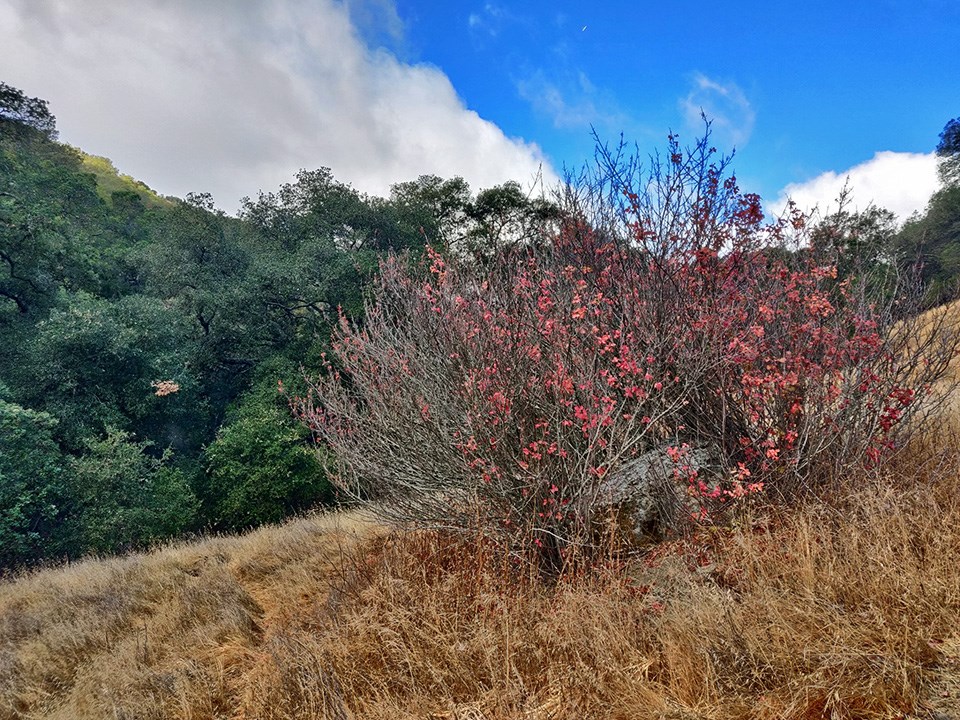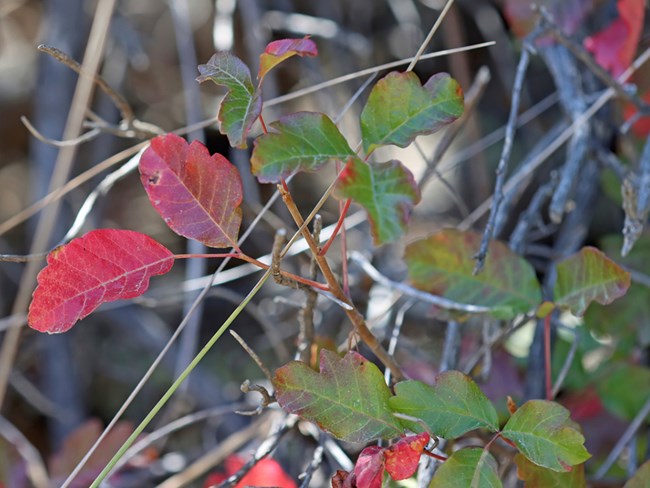Last updated: October 28, 2021
Article
Trials, Trails, and Tribulations of a Biological Plant Field Technician: Perspectives on Poison Oak

© Alex Wentworth / Photo 165619697 / 2021-10 / iNaturalist.org / CC BY-NC
By Mackenzie Morris, Plant Community Monitoring Technician
October 2021 - Botany sounds glamorous. At least, when I was young and first learned about the profession. Now, I am a field technician supporting the research of a botanist for the San Francisco Bay Area Inventory & Monitoring Network. I have traversed Golden Gate National Recreation Area and Point Reyes National Seashore studying plant communities and taking in the beauty that surrounds me in the field. The glamour is certainly present. But just like life, the good comes with its own set of challenges. In most cases the challenge is poison oak, Toxicodendron diverselobum. Of course, not all plant communities are riddled with this shiny, three leafed nemesis, but most of the coast live oak woodlands are smothered by it. Let this be a warning to all who want to stray away from the trail: stay on it, because you will quickly find yourself immersed in a sea of red and green.
In a practice of staying present and letting go, I am able to forget about the toxic oil of poison oak. I can see what a beautiful plant it truly is. Many forms, many colors, and cascading flowers. Often the most vibrant and lush of species in our plots. In open sunlight, poison oak grows as a dense, tall shrub, but in the shade of a forest it grows in thickets and sends strong vines up trees.

© Steve Collins / Photo 165114020 / 2021-10 / iNaturalist.org / CC BY-NC
As a human vulnerable to its poison, I don’t have a natural appreciation for this species. But I wonder: if it is so prevalent in our plots, who might have a love for it, or a symbiotic relationship with it? According to CalScape, many native animals, like deer and squirrels, are able to feed on the leaves of the plant. The leaves pack a punch with nutrients like phosphorus, calcium, and sulfur. Birds find berries to feed their bellies and can use the vining structure of the plant to shelter themselves.
While conducting our inventorying and monitoring protocols, we are gentle and do not trample any of the plants even if we may have some unresolved feelings towards poison oak. We know that it is a shelter and a resource to our winged and four legged friends. While measuring the diameter of trees, we weave our DBH (diameter at breast height) tapemeasure through the vines of Toxicodendron diversilobum to ensure that we are getting an accurate diametric read, and that we are kind to both our skin and the structure of the plant community. When moving to and through the plot, we follow deer paths and when we must break from those to make our own path, we retrace those steps. Please keep these same practices in mind when visiting and working in our parks. Stick to the maintained trail, avoid social trails that destroy native vegetation and when you must stray from the trail, follow deer paths.
Despite all caution, our team has fallen victim to poison oak’s urushiol oil. However, preventative measures have kept me safe and may keep you safe as well. Wear thin, long sleeve shirts (especially ones with thumb holes), and if you have gloves, wear those too. This will keep your arms, wrists, and hands safe from both sun and poison oak. When we work in the field, we wear jumpsuits to protect our clothes from carrying the oil back home with us. All of this protection is great, until you walk face first into a poison oak branch. When this happens, we turn to our best friend, Tecnu, a soap that strips urushiol from skin. My best tip for you is to recycle mini hand sanitizer bottles, the ones we are all so familiar with from the pandemic, and refill them with a product like Tecnu. These easily fit into your pocket and are a quick skin saving device. Once back to base, re-apply Tecnu again and wash it away with lukewarm water!
